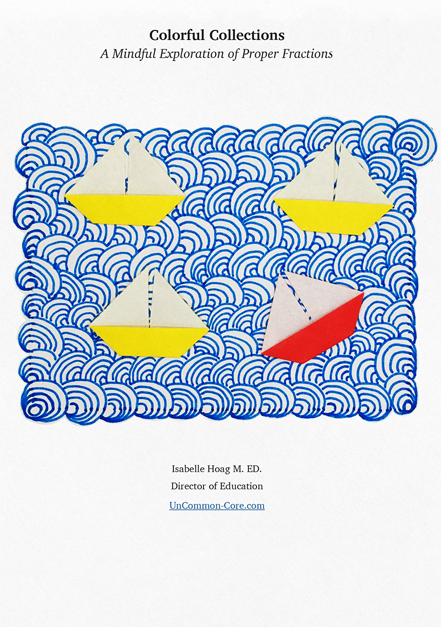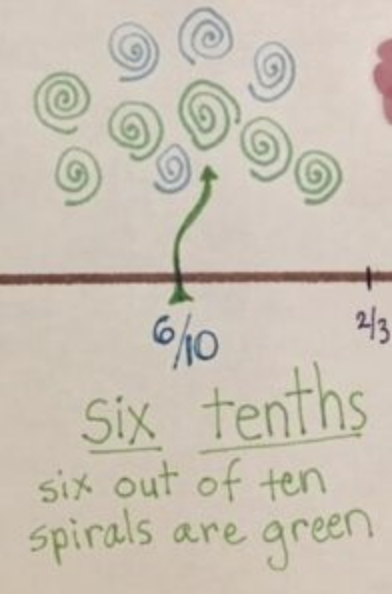
Introducing Fractions with Illustrated Number Lines
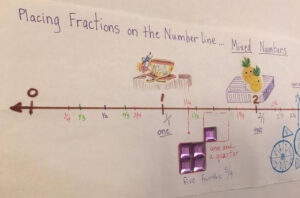 Birds on a wire, trees on the horizon, cars parked along the side of a street, or books on a library shelf. There are all kinds of natural number lines. Thermometers, railroad tracks, elevators, yardsticks, and sidewalks. Then there are the ubiquitous, ceiling-hugging, number lines found in every elementary classroom around the world.
Birds on a wire, trees on the horizon, cars parked along the side of a street, or books on a library shelf. There are all kinds of natural number lines. Thermometers, railroad tracks, elevators, yardsticks, and sidewalks. Then there are the ubiquitous, ceiling-hugging, number lines found in every elementary classroom around the world.
Number lines are everywhere. Even very young students are familiar with how number lines work and can easily learn to use them. Number lines are easily visualized and internalized.
They are a powerful mathematical tool.
Like most mathematical manipulatives, students need to ‘play around’ with number lines in order to explore all their exciting and important features before they are able to use number lines as a mathematical tool. Students can imagine the numbers getting bigger and bigger as they start from zero then zoom into infinity. Older students imagine numbers getting smaller and smaller as they start from zero and zip to the left. Negative numbers have special meaning for students living in climates with cold winters, or having experience with elevators in basements.
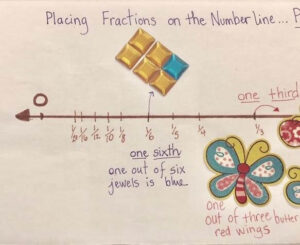
Student mathematicians are invited to assign a number to each graduation marked along the number line. Finally, students can imagine fractions and decimals for every tiny point between the whole numbers.
Just by thinking about this fantastic numerical beast, students can visualize all kinds of infinities and possibilities. Students’ conceptualization of number lines becomes more nuanced as they learn more about numbers and arithmetic.
Help Your Students Make the Most of Number Lines
Post a number line in your room. Point to it often. Use it for whole class counting, skip counting, addition/subtraction, multiplication/division, fractions, powers of ten for all kinds of numerical activities. As your students’ numeracy grows, intentionally connect each new math concept with how to visualize it on the number line. For example, if your class number line has alternating blue and red numbers, ask your students how they could make use of this while learning about even/odd numbers or as they practice skip counting.
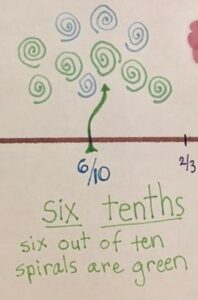 Provide small number lines for your students to use at their desks. Even older students need reminders after long vacations. Younger students might enjoy having an actual lily pad number line with a toy frog for special occasions. The frog lives on zero. Students count its hops. It is important for them to count the hops in order to get the correct results. As the frog hops up and down the number line students learn to conceptualize various math skills and build their number sense.
Provide small number lines for your students to use at their desks. Even older students need reminders after long vacations. Younger students might enjoy having an actual lily pad number line with a toy frog for special occasions. The frog lives on zero. Students count its hops. It is important for them to count the hops in order to get the correct results. As the frog hops up and down the number line students learn to conceptualize various math skills and build their number sense.
Anything that can be used on the wall or on a desk can be used on the floor. Play with scale by having large, medium, and small number lines available to students.
To help your students connect with and make the most of the number line, why not invite them to make their own. Every elementary classroom can benefit from a giant illustrated number line. Also have students make ‘take home’ versions of the classroom illustrated number line.
Make a Giant Illustrated Number Line with Fractions:
Creating a giant illustrated number line would be a fantastic blend of art and math for any age student. In the following example, the number line is being used to introduce fractions.
Post a large blank number line on the wall a couple of weeks before you introduce fractions to your students. Start the number line with zero. Have it go up to one or maybe as far as two. This giant blank space will act as a visual invitation. It will get your students interested. They will wonder how to fill the space. You might post a question sheet next to it where students can share questions. You could build your number line on butcher’s block paper, bulletin board paper, or whatever you have handy.
Consider fractions from a child’s point of view:
It can take a while for kids to get used to rational numbers. Before learning about fractions, students thought that each number had its own unique place on the number line. Before fractions, there were generous spaces between each number, and counting was easy. Suddenly, there are rational numbers squished onto every little point, creating an infinity of fractions between each whole number. To make things more interesting, whole numbers can be thought of and written down as fractions, too. Did I mention that each fraction can be written an infinity of different ways? Like secret agents wearing multiple disguises – equivalent fractions have to be investigated until their real identity, their simplest form, can be discovered. Only then can we see where they truly belong on the number line.
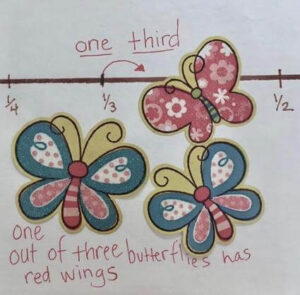 Materials:
Materials:
Butcher block paper or other large paper to use for the class number line, markers, yardstick, staples, tape, or stick-um to hang the number line, crafty items for students to use to illustrate fractions (these could include die cut shapes, potato prints or other artistic designs, stickers, adhesive gems, markers, crayons, origami flowers, photocopies of shells, and so on), scissors, glue, and pieces of paper for students use to post their contributions onto the number line. Camera or smartphone to capture the project start to finish and/or capture individual student’s contributions. Desk size number lines for each student to create his or her own illustrated number line and take it home.
Planning & preparation:
I like to have students work on pieces of paper separate from the large number line. That way I can check their work before it is added to the main project. This gives students a chance to make mistakes without ‘ruining’ the final product. Everyone will have a chance to display their best efforts. It also allows for repositioning any illustrations that accidentally get posted in the wrong place.
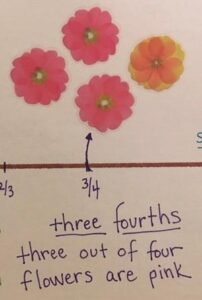 Collect stamps, stickers, shapes, pictures, and designs that can be used to illustrate fractions. Think twice when choosing images of living things (other than plants with radial symmetry). This is for two reasons. First, animals such as fish, unicorns, cute little puppies or soft, fluffy kittens might have bilateral symmetry depending on how they are pictured, but that’s it. Dividing these images into more than two equal sections could be challenging. Second, pieces of puppies, sliced squids, or butchered butterflies do not make an inviting, joyful display. Choose illustrations which will enhance the number line, not distract from it. On the other hand, images of animals could be used to show fractional parts of sets. For example, seven-eighths out of 16 frogs could be yellow. The art teacher might be a good resource here.
Collect stamps, stickers, shapes, pictures, and designs that can be used to illustrate fractions. Think twice when choosing images of living things (other than plants with radial symmetry). This is for two reasons. First, animals such as fish, unicorns, cute little puppies or soft, fluffy kittens might have bilateral symmetry depending on how they are pictured, but that’s it. Dividing these images into more than two equal sections could be challenging. Second, pieces of puppies, sliced squids, or butchered butterflies do not make an inviting, joyful display. Choose illustrations which will enhance the number line, not distract from it. On the other hand, images of animals could be used to show fractional parts of sets. For example, seven-eighths out of 16 frogs could be yellow. The art teacher might be a good resource here.
Due to the number of obese and diabetic children, you may decide to steer clear of images of cookies, candies, cakes, pizzas, and the like. When using images of food, please be mindful of socio-cultural influences in your class. For example, you might want to avoid using images of food during Ramadan, Lent, or Yom Kippur. Also, please be aware that some of your students may use food shelves or have experience with hunger. It is always safe to avoid using pictures of food.
Visualize the final result. Will it be as long as the hallway with one number for each child in class? Or will it be a vertical? What part of the number line will be shown? Older students might benefit from illustrating a floor to ceiling number line showing the numbers from -1 to 2. This number line could have decimals to one side of the line and fractions on the other. Make sure there is a lot of space for fractions between the whole numbers.
You can make the blank number line after class or have your students make the number line during class. Divide the class into pairs or teams. Assign each team a certain part of the number line to create. Team roles might include: using yardstick and pencil to draw a straight line down the middle of the paper; using the yardstick and a marker to trace the line; use the yardstick and pencil to mark a line for each whole number; use a marker and straightedge to trace over these lines; use pencil and 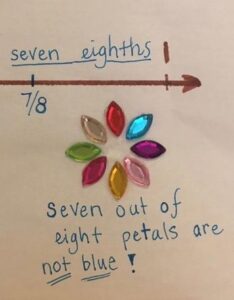 yardstick to mark fractions according to list from the teacher; trace the fraction lines in marker; add the whole numbers to the number line; and hang it in place.
yardstick to mark fractions according to list from the teacher; trace the fraction lines in marker; add the whole numbers to the number line; and hang it in place.
Prepare a demonstration for a whole class lesson to show students how to go about adding to the number line. Start with one half as everyone is most likely to be familiar with that fraction. Create an artistic representation of one half together as a class. Label it including examples of the work you expect your students to do. In the picture at the left you can see that the teacher expects students to create an artistic representation of the fraction, then write it in numbers, in words, and write a description telling how the picture represents the fraction.
Decide how your students can help decorate the number line. You might want to create a ‘fraction kit’ for each student, pair of students or group to help them get started. This kit would have the name of the fraction that group was illustrating and the materials needed to create the illustration. For example, if the assigned fraction is ¾, the kit could include a colorful circle which would stand for one whole thing and a piece of paper to work on. The students would measure and cut the circle into fourths, paste three of the quarters onto the piece of paper, and write the necessary information that goes with their fraction: “3/4, three-fourths, three quarters, three out of four equal parts.” Design a system for ensuring that the work has been done correctly, then supervise the students while they add their illustrations to the number line. Make sure they put the illustration in the right place.
As your students become more proficient at placing fractions on the number line, you might decide to introduce new concepts.
After your students are able to place fractions that are not in simplest form on the number line, you could use that skill to introduce equivalent fractions. Sort your students into working groups. Give each group a fraction ‘kit’ as described above. The task is for them to create the fraction with the given materials, write the information on the paper, have you check it, and then post it on the number line. Give out kits to make the following fractions: 4/6, 6/9, and 6/8, 9/12 and 2/8, 3/12 and so on. What will your students do when it comes time to place their illustrations on the number line and find that their friends’ fraction also belongs in the same place? Be prepared for some animated discussions as two groups try to add their fractions to the same place on the number line.
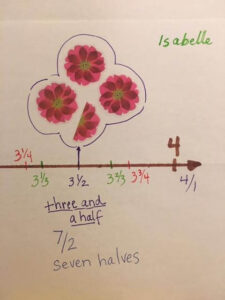 Another way to mix things up is to create ‘fraction kits’ with the pieces already cut. In the case of conceptualizing improper fractions, there could be a kit with 7 half pieces of flower stickers. The task would be to combine as many halves as possible into whole flowers in order to find the mixed number that is equivalent to seven-halves. Before tackling any symbolic description of an operation or abstract concept, find ways to let your students try it for themselves in the process of illustrating the class number line.
Another way to mix things up is to create ‘fraction kits’ with the pieces already cut. In the case of conceptualizing improper fractions, there could be a kit with 7 half pieces of flower stickers. The task would be to combine as many halves as possible into whole flowers in order to find the mixed number that is equivalent to seven-halves. Before tackling any symbolic description of an operation or abstract concept, find ways to let your students try it for themselves in the process of illustrating the class number line.
Look out for opportunities to involve students during spare time, rainy recesses, or by providing meaningful homework. Expect some students to contribute more than others. Value everyone’s
contributions. You might want to photograph the completed project and let each student keep a picture of it. Be sure to use the number line during math lessons; refer to it often when comparing fractions or use it to help solve problems. You might even have each student create and place one final illustration as an assessment of their understanding of fractions. Children need a lot of practice locating fractions on number lines in order to conceptualize this new kind of number. Illustrating number lines is a fun and satisfying way to get that practice.
Math students use manipulatives to create mental models which help them understand numbers and solve math problems. The number line is an effective device which can be used throughout their lives to help students think about numbers, numerical relationships, and calculations.
Teachers can help their students make the most of the number line by showing them increasingly complex ways to think about numbers in long lines and giving them opportunities to interact with number lines as they learn new skills and concepts. Illustrating number lines invites students to construct and explain artistic representations of numbers which can be used to embellish their class number line. This activity engages students in memorable, personalized experiences as they design and discuss illustrated number lines in math class.
There are many roads to success. Find yours.
Share This Story, Choose Your Platform!
Download Colorful Collections:
A Mindful Exploration of Proper Fractions
Help your students make sense of fractions.
I started teaching in 1987, which means I’ve collected many tips and tricks along the way. In this ebook, I share concepts, strategies, and classroom materials to help you make math sticky.
Along with this useful ebook, you will receive weekly emails from StickyMath@UnCommon-Core.com. I send information like: teacher tips, educational ideas, book reviews, curated lists, reviews of educational sites, and free first drafts of products that I’m creating for my TPT store. That way, you get helpful ideas and free stuff, while I get some feedback before I finalize products and put them up for sale.
I value your privacy. I will never sell your information. You may unsubscribe at any time.
All the best!
Isabelle
Isabelle Hoag M. Ed.
